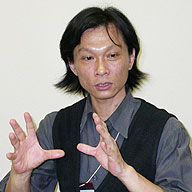An Interview with Wang Chung-hsiung
The Life of Culture Itself Changes
Q: What initially led you to shoot Wulu Village?
WC: This comes out in the film, but there was a project to record a session with cellist David Darling and the Bunun people, and the producer asked me about trying to shoot it as a documentary. I decided to take it on, though it was the first time for me to shoot a documentary on a subject like this. I wanted to shoot the cultural collision between the Bunun people, who are indigenous, and myself as a contemporary Taiwanese. And it occurred to me that a theme like this is a very international subject that goes beyond Taiwan and its indigenous peoples.

Q: As you progressed with the filming, what kinds of things gradually changed in your mental outlook?
WC: Right after I arrived my feeling was that the village’s culture would probably vanish with time, but my attitude gradually changed as I kept coming back to the village to film. Culture can’t be understood as either existing or not existing. I started feeling like it wasn’t about disappearing or not disappearing. Meaning that if culture was something that could suddenly vanish or be preserved, then you could just stick things in museums and say they still existed. But I couldn’t see things that way. I thought that preserving their culture meant incorporating new change. It gradually came home to me that culture is something that should change with time, and it changes naturally. What I mean is that the picture changes a lot from the scene where cellist David Darling appears. The overall rhythm gets smoother. Gradually I came to see what it means for something to be alive, how culture infused with life changes.
Q: The film crew and slate appear a lot in the film.
WC: There are two reasons for this. First, I wanted the audience to be aware that the images they are viewing are seen through the camera, through the eyes of the filmmakers. I wanted to convey that ultimately images are nothing more than the filmmakers’ perspective seen through the finder. Second, it just happened naturally. I wanted to shoot the natural atmosphere, just like it happened.
Q: What is your attitude now that the piece is completed?
WC: What I got from making this piece was the realization that culture can’t be grasped as something that just vanishes or doesn’t vanish. Culture itself has life, and this life continues to change. That is what I was able to understand.
Q: What is your next piece?
WC: Right now I’m thinking about “the relationship between pets and people.” There are people who are more saddened by the death of their pet than by the death of their own flesh and blood. Why are people affected so deeply? Some say it’s because your pet will never betray you, but people hurt each other. It’s really fascinating to me. I want to try getting at the true nature of people through pets.
(Compiled by Hayashishita Sayo)
Interviewers: Hayashishita Sayo, Wada Hiroshi / Interpreter: Higuchi Yuko
Photography: Sato Akari / Video: Sonobe Mamiko / 2003-10-12
